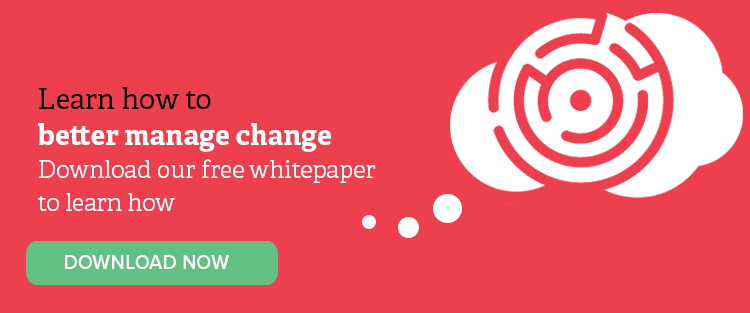Research shows that 70% of business transformations fail. Despite this, the need to adapt and evolve has never been more important. In a dynamic marketplace, an ability to change helps businesses maintain or gain a competitive edge.
But poorly managed organisational change can lead to a number of costly problems: drops in employee morale, damaged confidence in leadership, increased staff turnover, wasted time and money. At its worst, poorly managed change can end in bankruptcy for even the savviest of businesses.
So in an environment where change is essential, but also highly risky, how do you maximise your chance of successfully implementing change?
According to change management Thought Leader and author of Leading Change, John Kotter, “The central issue for business is never strategy, structure, culture or systems. The core of the matter is always about changing the behaviour of people.”
In other words, the issue is rarely about pivots in a business’s strategy, but rather, about how the change process has been managed.
Why do people resist being changed?
In essence, it all comes down to mindset.
Your mindset is the set of core beliefs you have about the world. It informs your perceptions, opinions, behaviours and every decision you make. We start developing mindsets at a very young age and continue to shape these as we grow – they come from our parents, our family, our school, our friends, our work and our personal experiences.
These mindsets are extremely difficult to change because it’s what you believe to be true. Mindsets are firmly set and isolated facts will do little to change them. Ever tried to convince an iPhone owner to make the switch to Android? It can be like talking to a brick wall.
This fixed mindset can negatively impact business decisions the same way it can personal decisions. A business stuck in its mindset can miss out on opportunities to better meet customer needs, improve internal processes or develop innovative ideas. Take, for example, Nokia. The mobile manufacturing company refused to embrace Android, stuck in the mindset that users would reject touch screen technology. It wasn’t long before Nokia was surpassed by its competitors.
How to understand and alter mindsets to facilitate change
If someone is stuck in their mindset, facts alone won’t work. To break through the mindset barrier you need to look at how your employees’ minds work. This is where Whole Brain® Thinking and agile thinking come in to play.
The Whole Brain® Thinking Model provides a framework for looking at different mindsets and determining how each of the four mindsets deal with change.

The four-colour, four-quadrant graphic and Whole Brain® are trademarks of Herrmann Global © 2019
For example:
- Those in the A quadrant may want to approach change logically but could be uncomfortable with the unknown
- Those in the B quadrant may require a clear plan, but could feel a lack of security and be uncomfortable with new approaches
- Those in the C quadrant may prefer to engage in conversation about the change, but could be highly emotional and may tune out the details
- Those in the D quadrant may react spontaneously and not be too worried about the details at first, but could worry about their loss of freedom of choice
Leaders managing change will most likely encounter a variety of different mindsets. The key to successfully implementing change is recognising, understanding and engaging with each mindset, and ensuring you’re speaking to each mindset in a language that they understand. This is the essence of inclusive leadership.
Agile thinking, or the ability to switch between thinking styles based on the situation at hand, gives you the ability to look at the change process from all the different angles – so you can empathise and understand why the employees in quadrant A need to know the facts and financial consequences of change, and why those in quadrant C need to talk about the impact the change will have on their team. You can then address those needs to get people on board with the business change.
How to use agile thinking in your change management plan
If you’re implementing change in your business, the key to success is better engaging your employees in the change process, taking into account their individual mindsets. For this, you need to be an agile thinker and an inclusive leader.
Download our Change Management whitepaper to learn how to appreciate, understand and communicate with different mindsets to get them on board with change.


